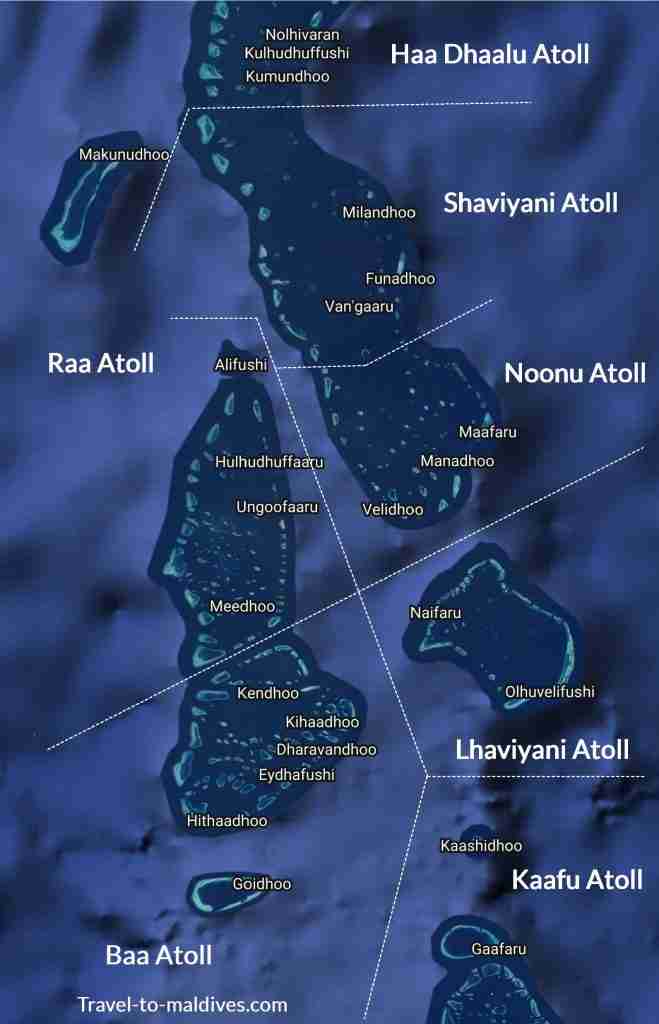Where is Lhaviyani Atoll Located?
Geography and Location On The Map

Lhaviyani Atoll, also known as Faadhippolhu Atoll, is a mesmerizing destination in the Maldives archipelago’s northern part. It is between the Kaafu Atoll to the south and the Noonu Atoll to the North.
Geographically, Lhaviyani Atoll spans approximately 55 kilometers from north to south and 23 kilometers from east to west.
The land area of Lhaviyani Atoll is 31 square kilometers, and the water area is 953 square kilometers.
Islands In Lhaviyani Atoll
Lhaviyani Atoll consists of 54 islands, both inhabited and uninhabited. The largest islands in the atoll include Naifaru, the administrative capital, Hinnavaru, and Kurendhoo.
These islands showcase the natural beauty of the Maldives with their white sandy beaches, lush tropical vegetation, and crystal-clear turquoise waters.
Characteristics of Lhaviyani Atoll
Lhaviyani Atoll is renowned for its stunning natural beauty, pristine beaches, and abundant marine life. It exudes a serene ambiance, making it an ideal destination for those seeking a peaceful retreat.
Its unspoiled surroundings characterize the atoll, where turquoise lagoons meet vibrant coral reefs and lush underwater gardens. Lhaviyani Atoll offers a perfect blend of secluded relaxation and exciting water sports and activities opportunities.
Tourism in Lhaviyani Atoll
Lhaviyani Atoll is gaining popularity among travelers for its untouched beauty and serene atmosphere. The atoll’s limited tourism infrastructure ensures visitors an exclusive and intimate experience.
Resorts in Lhaviyani Atoll are known for their luxurious amenities, stunning overwater villas, and world-class service. Whether you seek a romantic getaway or a family vacation, Lhaviyani Atoll offers a range of accommodations to suit various preferences and budgets.
Diving Sites
Lhaviyani Atoll boasts remarkable diving sites that attract underwater enthusiasts worldwide. The atoll’s diverse marine ecosystem is teeming with vibrant coral reefs, colorful fish species, and abundant marine life. Popular diving sites in Lhaviyani Atoll include Kuredu Express, a thrilling drift dive known for its strong currents and encounters with large pelagic species.
Other notable sites include Fushivaru Thila, where divers can explore underwater caves and swim alongside schools of tropical fish.
Resorts and Accommodation
Lhaviyani Atoll offers a range of luxurious resorts and hotels, each providing guests with a unique and idyllic experience.
From private overwater villas to beachfront bungalows, the accommodations in Lhaviyani Atoll are designed to provide the utmost comfort and relaxation.
The resorts boast world-class facilities, including spa centers, fine dining restaurants, and a variety of water sports activities.
Local Population and Transportation
Local Population
Lhaviyani Atoll has a small local population residing in the inhabited islands .
The local communities are known for their warm hospitality and cultural traditions.
Interacting with the locals provides an opportunity to learn about their way of life, traditional arts and crafts, and Maldivian customs.
How do I get to Lhaviyani Atoll?
To reach Lhaviyani Atoll, travelers typically fly into Malé International Airport (MLE), the main gateway to the Maldives.
From Malé, a domestic flight to Ifuru Airport is the most common way to reach Lhaviyani Atoll. The flight duration is approximately 45 minutes.
Once at Ifuru Airport, resorts in Lhaviyani Atoll arrange for guests to be transferred to their destinations via speedboat or seaplane, offering breathtaking aerial views of the atoll.
Lhaviyani Atoll captivates visitors with its untouched natural beauty, pristine beaches, and remarkable marine life.
The atoll’s secluded ambiance and luxurious resorts make it an ideal serene and exclusive escape destination. With its abundant diving sites, vibrant coral reefs, and the warm hospitality of the local community, Lhaviyani Atoll offers an unforgettable experience for those seeking tranquility and a deep connection with nature in the Maldives.